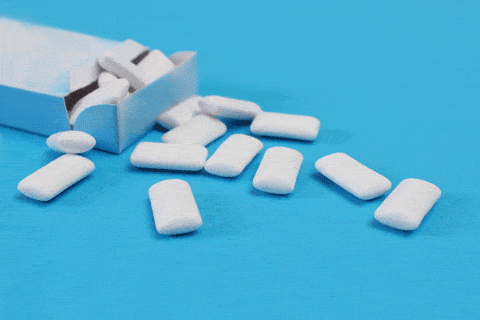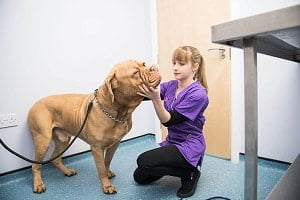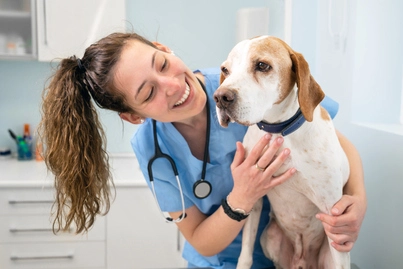Does your dog eat almost anything in sight?
Well, that’s what dogs do, anyway!
But the thing is that sometimes, human food isn’t really good for dogs, so I totally understand your panic. And it’s always a good idea to confirm if your dog can or can’t eat something humans do before you feed him.
So, today we’ll talk about what you should do if your dog ate gum and if you need to panic or not.
Are you ready? Let’s go!
Connect with a verified veterinarian in minutes. No waiting for appointments or office hours. No high fees. Your pet's health made convenient and worry-free.
Can Dogs Eat Gums?
The first thing I’d like to address is if your dog can even eat gum.
Well, the fact of the matter is that gum is in no way good for your furry bundle of joy.
That being said, gum comes in two variants; sugared and sugar-free gum. The thing here to note is that sugared gum is relatively less harmful to your dog than sugar-free gum.
In the case of sugared gum, your major concern is basically the same thing that you worry about when you’ve swallowed some gum.
So, why is that a problem?
Well, the thing is that it takes a long time for it to get out of your dog’s system. Also, it can do some damage to your friend’s insides if it’s left unchecked.
What I’m trying to say is that even if this isn’t very good, it’s really nothing compared to those harmful effects of your friend eating the sugar-free kind of gum.
All About Your Dog and Sugar-Free Gum
Well, in the last section, I talked about how sugar-free gum is more harmful to your dog than the sugared kind. In this section, I’ll go into more detail about sugar-free gum.

Ready? Let’s begin!
I’ll start with this first: If your dog swallowed down some of that sugar-free kind of gum, then you need to act as soon as you can.
The thing is that most sugar-free gums happen to contain a compound named xylitol, which is basically an artificial sweetener. So, what’s this Xylitol all about?
Well, Xylitol a naturally occurring sugar alcohol. Also, some traces of it can be found in all types of foods, like corn, oats, berries, etc.
The thing is that Xylitol isn’t really harmful to dogs when it is present in its natural state. This means that there is no harm if your dog likes to have those occasional berries as a treat now and then.
Xylitol and Your Dog
So, the Xylitol in our chewing gums and other stuff that we use, like candies, breath mints, mouthwash, toothpaste, etc., are actually extracted from places like hardwood trees and corn fiber to use as a substitute for natural sugar.
So, what’s this got to do with your dog?
Well, I’ll explain…
The thing is that it takes only a small amount of xylitol to do harm to your dog. In fact, only about 50 milligrams/pound of body weight dosage can result in hypoglycemia in your dog.
This means that if you’ve got a really small dog or one of those toy breeds, then only a tiny amount of Trident gum can wreak havoc.
So, what does Xylitol do?
Well, Xylitol toxicity can cause hypoglycemia, or low blood sugar, which will make your dog less alert and a little sluggish.
Apart from that, dogs also tend to experience really low potassium levels thanks to Xylitol. Vomiting and loose or “off” coordination of limbs is also a symptom. But, the worst of all of the symptoms are seizures and collapse.
There’s more to the story, though.
If your dog happens to have had a large quantity of xylitol, he may even start developing liver failure! What you need to look out for in this case are signs that’ll indicate hypoglycemia.
That being said, remember that the amount of xylitol required for such an awful reaction will totally depend on the breed of your dog and its size.
Note that the symptoms start occurring within fifteen minutes of having xylitol. This means that you don’t have time to waste, and you need to act fast.
Help! My Dog Ate Sugar-Free Gum!
Now, if your dog has eaten some gum with xylitol in it, then you need to act fast!
I’d like to start by saying that you needn’t go into a panic if your dog ate gum with xylitol in it if you’ve caught him early enough. The good news is that prognosis is good if this toxicity is handled early.
Make sure that you get into the car and take your dog to the vet as soon as you can before your pup’s liver starts to fail. This is because if you are late and if your dog has liver failure or any internal bleeding, it may slip into a coma.
This means that the prognosis may not be good later. So, rush to the vet.
Connect with a verified veterinarian in minutes. No waiting for appointments or office hours. No high fees. Your pet's health made convenient and worry-free.
At the Vet: What to Expect
You need to trust your vet completely, as they are the only ones who can take the best care of your dog during this time. Your dog’s blood sugar levels will be monitored closely and will be adjusted accordingly to keep them normal.

Since this is a really tricky situation, the vet may skip the diagnosis part and jump straight to the treatment part in this critical situation. The treatment will be as fast and as aggressive as possible to keep your dog safe and sound.
The main aim of this fast and aggressive course of action is to prevent drastic symptoms from happening due to hypoglycemia. The first thing that your vet may try to do would be to induce vomiting so as to get the gum out of your dog’s system.
The goal of this is that your dog doesn’t absorb a lot of xylitol.
But what about the antidote?
Well, the problem is that there isn’t an antidote developed for xylitol. So, it is probable that your vet may hospitalize your dog. He may even give your friend some IV fluids and liver protectants and may even perform blood work.
Ultimately, the gum will pass naturally, and there won’t be any need to worry more about xylitol toxicity.
Prevention is Better Than Cure
As you can see, your dog having some of that sugar-free gum can turn into an awful thing. So, it is really important for you to try and make your house a safer place for your dog and try to eliminate the possibility of your dog even having gum!
Ready for some gum-proofing? Well, let’s begin!
So, you know that chocolate is toxic to your dog, and I’m sure you don’t keep it lying around the house. You need to be more cautious with the sugar-free gum lying around in the house.
Why do you ask?
Well, the thing is that xylitol is about 100 times (yes, one hundred!) more toxic than chocolate. So, hide that gum, y’all.
Let’s do some math, shall we?
Let’s assume that you’ve got a tiny furry munchkin, like a 10-pound Maltese. Well, with him, about half a bar of chocolate may prove to be possibly fatal.
Now, compare that to your favorite cinnamon Trident, and you’ll find that it’ll only take three pieces of it to do the exact same damage to your pup.
Take It Seriously!
You must be wondering exactly what I am getting at here by talking about chocolates and bubble gum.
Well, I’m trying to tell you that you shouldn’t take this lightly. This, instead, needs to be a cause for panic. We all know about chocolate’s toxic nature for dogs, and it’s been engraved into our minds that we keep chocolate far away from our pup’s reach unconsciously.
The thing is that…
When it comes to gum, we slack, maybe because of a lack of knowledge. Now, do the math; when only three pieces of gum can prove deadly, we should be extra cautious with keeping gum around the house before anything dangerous can happen.
Now, as common sense suggests, you need to keep your guilty pleasure pack of gums in lock up!
Okay, you don’t need to be THAT cautious, but you should for sure try to nip the problem right in the bud and stop the awfulness before it even happens. Make sure that you don’t leave any gum in places that your dog can access with its mouth.
Another thing to note is that it’s not just cats that are curious by nature. If your dog finds you having a piece of gum, he’d want to join in, too!
Apart from that, I even suggest that you keep a check on all the products in your house that happen to contain xylitol, like cough syrup, mouthwash, etc. Make sure that you keep such items as far from your dog’s reach as possible.
In fact, you can keep a locked cabinet for all those things that contain xylitol in them just to ensure no accidents occur.
So, Where Do We Stand?
So, let’s take a quick recap, shall we?
Well, first and foremost, you need to realize that gum is not good for your dog at all because they stay in your dog’s system for what seems like forever and may do some damage while inside.
- Gums that contain real sugar are better than sugar-free ones, and you don’t need to panic if your dog takes some.
- Sugar-free gums contain xylitol which is toxic for your dog and can cause many problems like hypoglycemia, low blood sugar, and even liver failure!
- The thing to note here is that you need to take your dog to the vet as soon as possible because you can see the toxic effects within 15 minutes of your dog ingesting it.
- The prognosis is really good for your dog if you’ve caught this soon enough.
- Prevention is better than the cure here, so make sure that you keep sugar-free gums away from your dog!
I hope that I was able to help you with your question today. Always know that in such events, preventions are better than cure.

